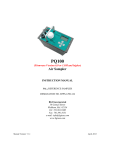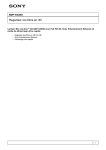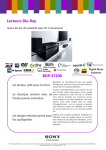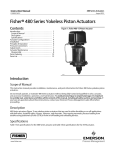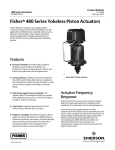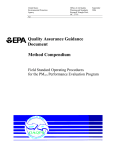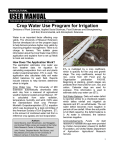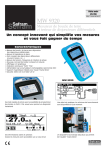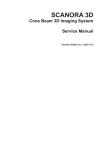Download Instruction Manual
Transcript
Maintenance Manual Procedures for Rebuilding the PQ100/200 Sampling Pump BGI Incorporated 58 Guinan Street Waltham, MA 02451 Tel: 781.891.9380 Fax: 781.891.8151 Email: [email protected] Web Site: www.bgiusa.com Version 3.1 June 2009 Table of Contents Section Number Topic Page 1.0 Introduction 1 2.0 When to Rebuild 1 3.0 Disassembly and Inspection 1 3.1 Motor/Bearing Assembly 2 3.2 Valve Removal 3 3.3 Valve Inspection 3 3.4 Diaphragm Removal 3 3.5 Diaphragm Inspection 4 4.0 Re-assembly 4 4.1 Diaphragm and Yoke Assembly 4 4.2 Valve Assembly 5 4.3 Diaphragm Setting 6 4.4 Motor Installation 6 5.0 Final Procedure 7 6.0 Disclaimer 7 Table 1 8 Figure 1 9 Figure 2 10 Revision History 11 1.0 Introduction The pump used in the BGI PQ100 and PQ200 air samplers is of BGI design and manufacture. The only items not of BGI manufacture are the motor and bearing for the eccentric. The basic design is a double diaphragm, steel reed valve, scotch yoke. This is a time-honored design. BGI’s contributions centered upon developing the most efficient unit for its intended application. Two unique BGI developments are the complete internalization of all flow transfer passages for noise minimization and the development of the technique for the preconvoluting flat diaphragms for maximum life and efficiency. 2.0 When to Rebuild The full question is when to rebuild and how many items to replace. There are two simple answers. 1. Rebuild the pump when it has ceased to function. 2. Rebuild when sufficient, in service hours have elapsed, to indicate that certain components are nearing the end of their effective service lifetime. Because of the variable use to which a pump is subjected, it is hard to quote a fixed number of hours for preventative maintenance. Experience has now shown, that when the pump is utilized for normal EPA type sampling, i.e. 16.7 Lpm at 30-50cm of H2O pressure drop, eight to nine thousand hours may be readily anticipated. This amounts to one year of continuous operation. Under idealized conditions, we have run the pump at 16.7 Lpm against 50cm of H2O for 18 months. The mode of failure was pump brush wear (brushes are non-replaceable). Bear in mind, given EPA sampling protocols 8-9000 hours is 2 years of every other day sampling, 3 years of every third day and 6 years of every sixth day! The following chart is a guide to preventative maintenance for absolute reliability. Replace Replace Replace Replace Motor: 9000 Hours Diaphragms: 9000 Hours Eccentric and Bearing: 14000 Hours Valves 14000 Hours Using the equipment for non EPA designated sampling at high flow rates and/or pressure drops may significantly abbreviate the above figures and it would not be imprudent to perform a complete rebuild at 5000 hours. It is always recommended that, when practical, pumps be factory rebuilt inasmuch as factory service will carry a one year warranty and client field service cannot. 3.0 Disassembly and Inspection All of the component parts of the pump are shown in Figure one and described in the parts list, Table One. Four levels of repair/rebuild kit are made available. Other than the parts listed in the kits, it is not anticipated that any other components will be required except through physical damage or loss. Rebuild Kits: Page 1 Catalog No. X017 X014 X015 X016 Quantity Description Detail No. 2 Diaphragms 2 2 8 2 2 8 1 Diaphragms Valves “O” Rings Diaphragms Valves “O” Rings Mounted Bearing 38 50 48 38 50 48 42, 43 38 2 2 8 1 Diaphragms Valves “O” Rings Mounted Bearing 38 50 48 42, 43 1 Motor 47 Part No. A2187 A2187 B1408 BUNA010 A2187 B1408 BUNA010 DDRI-6632, and A1294 A2187 B1408 BUNA010 DDRI-6632, and A1294 PQ Motor Note: In working on the pump unit, detail numbers refer to Figure 1 and Table 1. 3.1 Motor/Bearing Assembly Step 1-Required Remove two sheet metal screws (88) securing the motor to the pump body. The motor assembly may now be pulled away from the pump body. Inspect the eccentric/bearing (42, 43) for looseness on the shaft. Inspect the bearing for smooth rotation and absence of play. If these components are undamaged/unworn, then wipe the bearing clean with a fresh, lint free cloth and re-lubricate all over with any light grease. Set aside for reassembling. Step 2-If Required If the bearing requires replacement, loosen the set screw (44) on the eccentric shaft and remove the bearing/eccentric assembly (42,43). Replace with a new assembly, pushing it firmly on the shaft as far as it will go, before tightening the set screw. Step 2-If Required If the motor also requires replacement, then, after removing the bearing/eccentric assembly (42, 43) also remove the three motor plate screws (45) which secure the motor plate (46) to the motor (47). The new motor, which is furnished with the cable and connector, is assembled to the plate utilizing the three screws just removed (45). The eccentric and bearing (42, 43) are replaced as described in step 2 and the motor assembly is ready for re-attachment to the pump body. Page 2 3.2 Valve Removal Step 4-Required Before beginning valve disassembly, it is important to note that it is possible to mis-assemble this section so that the pump will fight itself and little or no air will be pumped. This can be avoided if the alignment of parts shown in Figure 1 is followed exactly. A simpler procedure is to scribe a line, free hand, across the entire face of the pump body marking parts 35, 36 and 40. By this procedure, it will be impossible to commit a misalignment error if the scribe marks are exactly aligned. Do not scribe the face containing the motor nor the mounting studs. This procedure is commonly used in machine assembly and is known as applying a witness mark. Step 5-Required Starting on either side of the pump remove 4 screws (86) from the valve upper plate (35) and lift off and set aside. The valve plate alignment pins (locating pins) (49) are pressed into the plate. Do not attempt to remove them. Carefully remove the valve (50) which may be lightly adhered to the upper or lower plate. Be extremely careful as this component is only 0.001 inch thick. Set aside for inspection. Next remove the valve lower plate (36). This component is usually a tight fit and a strong thumbnail or thin knife blade may be required. Set aside, taking care to remove and set aside the 4 “O” rings which have now become visible. Repeat the same procedure on the other side of the pump. 3.3 Valve Inspection Step 6-Required All metal parts now visible should be bright and clean, completely free of corrosion or dirt. The leaves of the valve should be nearly flat or only slightly curved. The edges of the leaves should be free of chips or cracks. If the valves are not perfect, they should be replaced. If they are dirty they should be carefully wiped clean. If the valves become bent or creased, they must be replaced. 3.4 Diaphragm Removal In August 2001 a new diaphragm was introduced. It can be redialy identified by its orange/red color and convolutions. If you have this diaphragm in your pump or are about to install them utilize sections 3.5A,4.1A and 4.3A. Step 7-Required The diaphragms are removed by grasping the diaphragm retainer (37) between the thumb and forefinger and rotating in a counter clockwise direction when looking down on it. This part is a white disk situated in the center of the diaphragm. The other hand is used to grasp the same component on the opposite side. In this manner one of the retainers may be removed. The remaining retainer is removed by inserting a finger throughout the bearing hole and forcing the yoke (41) against an inside wall. This will prevent its rotation and permit the removal (unscrewing) of the second retainer. You will now have removed both diaphragm retainers (37) and the yoke (41). Set these components aside for inspection. The Page 3 diaphragms may now be pulled from their recesses. If the diaphragms became dislodged and removed with the retainers, no harm has been done. Lay out all parts for inspection. 3.5 Diaphragm Inspection Step 8-Required A new diaphragm is quite flat. A used one takes on a curved shape with use which is both normal and desirable. All current production utilizes a highly specialized material, which contains an imbedded, woven nylon cloth. This material yields extremely long life and superior performance. All other diaphragms should be replaced. To inspect the condition of a diaphragm, grasp it across its diameter and pull in opposite directions. If any cracks in the surface are observed the diaphragm must be discarded. 3.5A Diaphragm Inspection (introduced Aug 2001) Step 8-Required All current production utilizes a highly specialized material, which contains an imbedded, woven Nomex cloth. This material yields extremely long life and superior performance. All other diaphragms should be replaced. To inspect the condition of a diaphragm, grasp it across its diameter and pull in opposite directions. If any cracks in the surface are observed the diaphragm must be discarded. 4.0 Re-assembly 4.1 Diaphragm and Yoke Assembly Step 9-Required If a new diaphragm is being installed it does not have a preferential side. If a used diaphragm is being re-installed it will be curved. When properly inserted you will be looking down into a cup shape. Insert the diaphragm retainer (37) into the diaphragm (38) and slide the diaphragm retainer bushing (39) over the diaphragm retainer shaft. Seize the follower yoke with a pair of long nose pliers and insert it through the drive hole in the pump housing (40). Align the threaded hole in the yoke, such that the diaphragm assembly may be inserted through its guide hole in the pump body and screwed into the yoke. Grasp the diaphragm retainer between the thumb and forefinger and rotate clockwise two turns. The diaphragm will be lying on top of the pump body. Leave it that way, for the moment. Discard the long nose pliers. Prepare the opposite diaphragm assembly and screw it into the yoke two turns, holding each assembly between the thumb and forefinger of each hand. The diaphragms may now be inserted into their recess. The edges of the disks are to be tucked into the recess provided in the Page 4 pump body (40). Looking through the drive hole align the yoke, by eye so that you are looking into the bearing drive recess and align it such that it will receive the eccentric bearing and is parallel to the pump sides and square to the face. Now complete tightening the loose diaphragm retainers to the yoke and check alignment. Install the 8 “O” rings (48) into the body and set the assembly aside. 4.1A Diaphragm and Yoke Assembly (introduced Aug 2001) Step 9-Required If a new or used convoluted diaphragm is being installed has a preferential side. If a used diaphragm is being re-installed it will be curved. Insert the diaphragm retainer (37) into the diaphragm (38) and slide the diaphragm retainer bushing (39) over the diaphragm retainer shaft. Reference Figure 1 inset for the direction of the convolution. Seize the follower yoke with a pair of long nose pliers and insert it through the drive hole in the pump housing (40). Align the threaded hole in the yoke, such that the diaphragm assembly may be inserted through its guide hole in the pump body and screwed into the yoke. Grasp the diaphragm retainer between the thumb and forefinger and rotate clockwise two turns. The diaphragm will be lying on top of the pump body. Leave it that way, for the moment. Discard the long nose pliers. Prepare the opposite diaphragm assembly and screw it into the yoke two turns, holding each assembly between the thumb and forefinger of each hand. The diaphragms may now be inserted into their recess. The edges of the disks are to be tucked into the recess provided in the pump body (40). Looking through the drive hole align the yoke, by eye so that you are looking into the bearing drive recess and align it such that it will receive the eccentric bearing and is parallel to the pump sides and square to the face. Now complete tightening the loose diaphragm retainers to the yoke and check alignment. Install the 8 “O” rings (48) into the body and set the assembly aside. 4.2 Valve Assembly Step 10-Required Lay the valve upper plate (35) outside face down on the bench. Lay the valve upper plate (50) onto the surface using the guide pins for alignment. If it is a used valve and the fingers have taken a curve, be certain that the curve is towards the round holes in the valve plate. Lay the flat surface of the valve lower plate (36) on top of the valve using the guide pin holes for alignment. Check to see that the witness mark, which you previously scribed onto these parts is aligned. If not, raise the lower valve plate and re-align. Place the valve assembly onto the pump body. Press it home into the diaphragm recess and align the witness marks on the valve plates with those on the body. Install the four securing screws (86) but do not fully tighten. Assemble and install the other valve components to the body in the same manner. Page 5 4.3 Diaphragm Setting This procedure must be successfully accomplished or the pump performance will be diminished and high current draw will ensue. Step 11-Required Place the forefinger into the center of the yoke and push it towards a diaphragm until it contacts the side of the recess. Tighten the 4 valve plate screws (86) on the side opposite to the one the yoke is being held against. This procedure has pulled down and pre-convoluted the diaphragm, which is now secure. Follow the same procedure for the other side. Your should now be able to move the yoke to either end of its stroke and easily contact the yoke to the pump body. If there is any springiness or resistance at the end of the stroke, repeat the procedure until success is achieved. When installing new diaphragms, it will be necessary to perform this operation two to three times. Note that after tightening the four screws (86), simply loosening them may not release the clamping pressure on the diaphragm. In this case, draw the valve assembly back to relieve the pressure and then push the yoke to the opposite side. 4.3A Diaphragm Setting (introduced Aug 2001) This procedure must be successfully accomplished or the pump performance will be diminished and high current draw will ensue. Step 11-Required The diaphragms will naturally center themselves so that the yoke is observed to be in the center of the drive hole. All 8 of the valve plate screws (86) may now be tightened. 4.4 Motor Installation Step 12-Required Place the motor assembly into the hole in the pump body and rotate it until the bearing engages the opening in the yoke (41). The motor plate will not lie flat to the body unless the bearing is engaged in the yoke. Once this is accomplished, align the two screw holes in the motor plate to the screw holes in the pump body. Re-install the two motor plate securing screws (88). Before fully tightening the screws, ensure that you observe an equal strip of the black delrin pump body around all four sides of the motor plate. In other words, centralize the motor plate on the pump body prior to final screw tightening. Page 6 5.0 Final Procedure Re-install the pump in the instrument and set up a run. When the pump comes on, ensure that it is drawing air through the instrument. If not, then the intake and exhaust pipes have been reversed. Place the suction hose onto the suction side of the pump and proceed to verify proper operation. If witness marks were not properly scribed onto the pump body prior to disassembly, or if several pumps have been disassembled or through malfortune, the valve plates have been improperly installed, refer to Figure 2. Following this figure, carefully, will permit the pump to be reassembled with the air flow paths in the proper direction. It is highly recommended to run a 24 hour burn in of a rebuilt pump to allow the diaphragms to settle. The only consequence of not following this procedure is a tendency to draw 10 to 15% higher current during the first 24 hours. When reinstalling a rebuilt pump for the first time, there may be a delay of up to 30 seconds before the pump “turns over”. This is within normal limits but should only occur, if at all, during the first start up. If 30 seconds has been exceeded, shut down at once. The assembly procedures have not been correctly followed. Check, particularly, pre convoluting of the diaphragms. If the pump runs but there is little or no air flow, check to ensure that one of the valve assemblies has not been reversed. If this has occurred, one side of the pump will be drawing air whilst the other side is pushing. Essentially, the pump is fighting itself. Disassemble and refer to Figure 2. Recalibration of a PQ100/200 is not required after the replacement/rebuilding of a pump. However, in following good practice it is always wise to verify flow calibration after replacing a major component 6.0 Disclaimer BGI accepts no responsibility for damage caused by successfully following the procedures detailed in this manual. If in doubt, return the pump to BGI for inspection/repair. Pumps are perfectly acceptable in a disassembled state. Page 7 Table 1 List of PQ 100/200 Pump Parts DET.# 35 36 37 38 39 40 41 42 43 44 45 46 47 48 49 50 86 87 88 89 QTY 2 2 2 2 2 1 1 1 1 1 3 1 1 8 4 2 8 2 2 2 FIG. 1 1 1 1 1 1 1 1 1 1 1 1 1 1 1 1 1 1 1 1 PART # B1292 B1293 A1288 A2187 A1289 B1283 A1287 DDRI-6632 A1294 SC0105 SC0106 A1290 PQMOTOR BUNA010 A1402 B1408 SC1014 A1403 SC1013 SC1015 DESCRIPTION Valve Upper Plate Valve Lower Plate Diaphragm Retainer Diaphragm Diaphragm Retainer Bushing Pump Housing Follower Yoke Bearing Eccentric M4 X 4mm Set Screw M2.5 X 8mm Cheese Head Screw Motor Mount Motor O-Rings Locating Pins Valves # 8 X 1 Sheet Metal Screws Pump Tubes #8 X 5/8 Sheet Metal Screws #8-32 X 11/4 Studs for Pump (PQ 200 only) Page 8 Figure 1 – Exploded Diagram of Pump Page 9 Page 10 Revision History V. 1.0 Initial Composition January 2000 V. 2.0 Revised text, added Figure 2 February 2000 V. 3.0 Updated for use with convoluted diaphragms August 2001 V. 3.1 Updated Figure 1 to show concave side June 2009 Page 11














